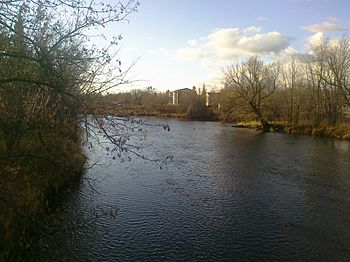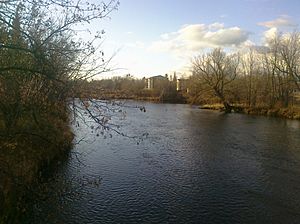Nicolet River facts for kids
Quick facts for kids Nicolet River |
|
|---|---|

Nicolet River in Kingsey Falls
|
|
| Native name | Rivière Nicolet |
| Country | Canada |
| Province | Quebec |
| Region | Centre-du-Québec |
| MRC | Nicolet-Yamaska Regional County Municipality |
| Physical characteristics | |
| Main source | Lake Nicolet Saints-Martyrs-Canadiens 350 metres (1,150 ft) 45°49′19″N 71°35′33″W / 45.82206°N 71.59259°W |
| River mouth | Lake Saint Pierre Nicolet 5 metres (16 ft) 46°15′09″N 72°39′09″W / 46.2526°N 72.6524°W --> |
| Length | 137 km (85 mi) |
| Basin features | |
| Progression | St. Lawrence River |
| River system | Saint Lawrence River |
| Basin size | 3,380 km2 (1,310 sq mi) |
| Tributaries |
cours d'eau Nolin, ruisseau Morin, ruisseau Turgeon, décharge du lac à la Truite.
|
The Nicolet River (French: Rivière Nicolet) is a river in Quebec, Canada. It is a tributary of the Saint Lawrence River on its southern shore and flows into Lake Saint Pierre. It is named in honor of the pioneer Jean Nicolet.
It has several tributaries including the River Bulstrode and the Nicolet River Southwest. Its watershed is mainly in the Centre-du-Québec region although the Southwest Nicolet rises in Estrie. The city of Nicolet is near its mouth on the lake Saint-Pierre which is crossed to the northwest by the St. Lawrence River.
Contents
Geography
Hydrology

The Nicolet River begins its course from 137 kilometres (85 mi) at an altitude of approximately 350 metres (1,150 ft) in lake Nicolet, at Saints-Martyrs-Canadiens. It then flows in a northwesterly direction to Nicolet where it flows into lac Saint-Pierre.
Its watershed has an area of 3,380 kilometres (2,100.23 mi). Its modulus is 79 cubic metres per second (2,800 cu ft/s). Its main tributaries are, from upstream to downstream, the rivers des Vases, des Pins, des Rosiers, Bulstrode and Nicolet Southwest. The latter, which joins the Nicolet at 5 kilometres (3.1 mi), drains half of the basin. The basin includes 40 lakes, the most important of which are lake Nicolet (401 hectares (990 acres)), les Trois Lacs (Les Sources) (225 hectares (560 acres)) and the Beaudet reservoir (88 hectares (220 acres)).
Geology
The part upstream of Saint-Léonard-d'Aston is part of the Appalaches. The subsoil is composed of sedimentary rocks folded and metamorphosed (shale, slate and sandstone), volcanic rocks (basalt) and ultramafic rocks (Serpentine and asbestos). As for the section downstream from Saint-Léonard-d'Aston, it is composed of sedimentary rocks (schist, dolomite, limestone, sandstone) in horizontal strata of the St. Lawrence Lowlands.
The unconsolidated deposits of the Quaternary of the St. Lawrence Lowlands are composed of clay, sand and gravel from the retreat of the Champlain Sea and peatlands. The Appalachian sector is composed of tills from the retreat of the glaciers and fluvioglacial deposits composed of sand and gravel.
Population
The basin was inhabited by 96665 inhabitants in 2003. The territory is included in 37 municipalities. The main towns in the basin are Victoriaville (39799 inhabitants), Nicolet (7963 inhabitants) and Asbestos (6627 inhabitants).
Toponymy
The river was initially baptized Rivière Du Pont by Samuel de Champlain in 1609 to honor his friend François Gravé, sieur du Pont. It also bore the name of Gast river, in honor of Pierre Dugua de Mons (general of New France) and Monet River, in honor of Pierre Monet, sieur de Moras. As for its current name, it owes it to the explorer Jean Nicolet. They also bore the name of the first lords of Nicolet, namely Laubia and Cressé. The Abenakis call it Pithiganitekw, which means 'river of the entrance', due to the fact that it flows near the outlet of lake Saint-Pierre.
The toponym "rivière Nicolet" was made official on December 5, 1968 at the Commission de toponymie du Québec.




